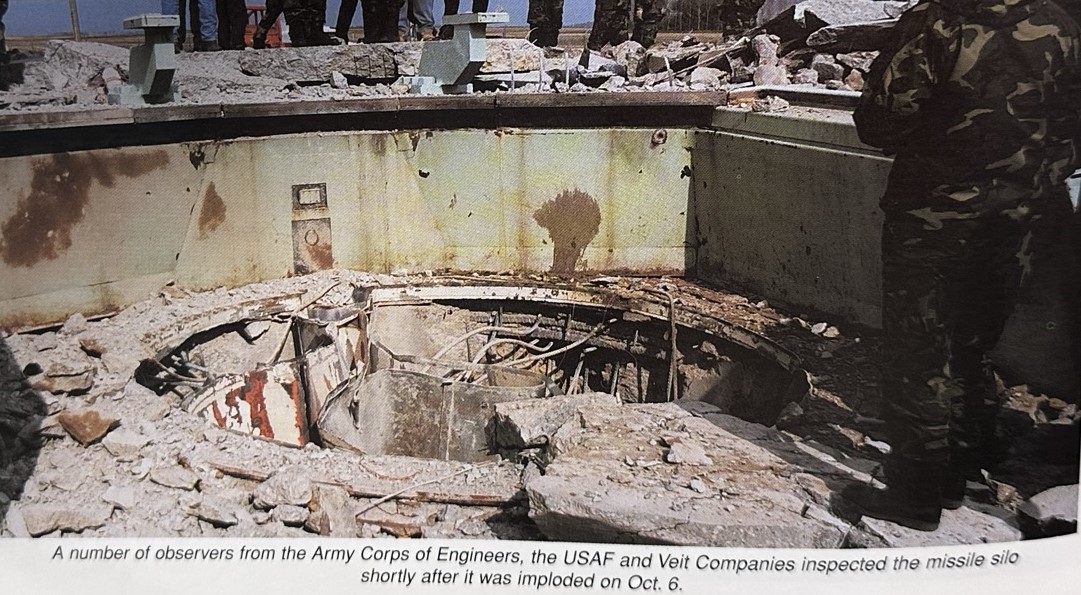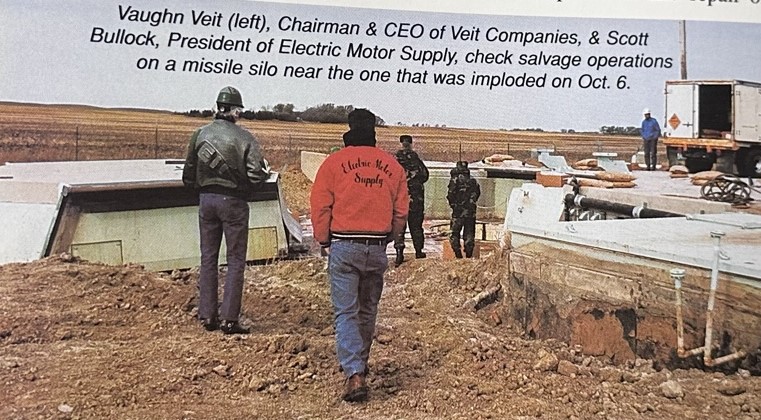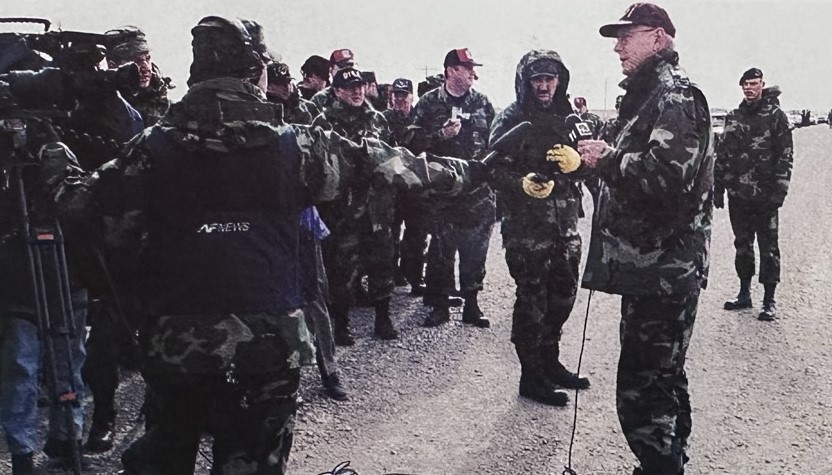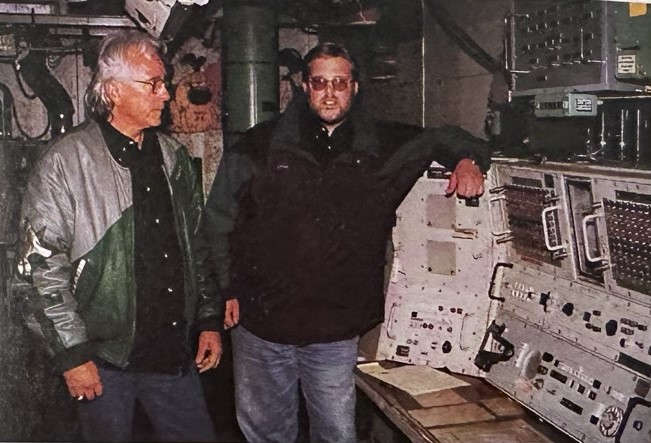Making the World Safer
September 26, 2023
By: Richard L. Parrish

This article was originally published in the Jan/Feb 2000 issue of DEMOLITION magazine, back when the National Demolition Association (NDA) was the National Association of Demolition Contractors (NADC).
Implosions at a number of missile silos thundered through the normally peaceful farmlands and quiet prairies near Langdon, North Dakota, on a regular basis late this fall. Most folks don’t seem to mind much, though, because the loud noise represents further proof that the expensive, nerve-wracking Cold War is finally over.
The first of 150 Minutemen 111 (MMIII) underground missile silos was imploded on Oct. 6. The massive project also includes filling and sealing 15 underground launch control facilities, removing 225 underground storage tanks, capping 180 wells, and remediation of 15 sewage lagoons.
The $12.2 million, three-year effort is being handled by NADC member Veit & Company of Rogers, Minnesota, one of the larger demolition, excavation and site prep contractors in the Upper Midwest. The job is also the largest and longest in the company’s 71-year history, according to Vaughn Veit, chairman and CEO.
“We thought the project fit us well, as far as demolition, excavation and environmental remediation are concerned,” Veit said. “I don’t know of any other contractor in the Midwest that offers all three of these services which are the main facets of the project. We believe that gave us an edge.”
Veit President Don Rachel added, “It’s a big job that most Midwest contractors just aren’t equipped to handle. We knew the big players were going to have to come from all parts of the country, so we thought we had a good chance from that standpoint.”

Getting STARTed
The contract with the U.S. Army Corps of Engineers is in compliance with START, the Strategic Arms Reduction Treaty of 1991. According to the U.S. Air Force (USAF), implementation of the treaty began in 1994 with removal of the missiles from the silos and dismantling nuclear warheads.
Earlier this year, Veit responded to an announcement in a regional construction magazine that the Corps was going to let the project in June, according to Bart Anderson, a vice president of Veit and manager of the project. More than 50 contractor representatives attended a pre-bid meeting, he said. The Corps and USAF outlined the scope of the project, presented details of the START treaty and conducted tours of the silos and launch control facilities.
When the bids were opened on May 25, Veit was low bidder by $600,000 with 16 other contractors submitting bids that ranged up to $32 million. The government had originally estimated the project at $25 million.
“The Corps delayed the actual award of the contract until August,” Anderson said, “which puts us three months behind schedule right from the get-go. Unfortunately, we lost June, July and August, which are the best working months of the year for us. But we still have to complete everything that’s called for in the contract on time because the end date of the treaty can’t be moved.”

Assembling and Mobilizing Forces
Veit has a full-time staff of three field supervisors in Langdon and an office in the same building as the Corps. The company uses seven subcontractors who specialize in blasting, underground storage tank removal, well abandonment, salvage and site prep. They also employ the services of an environmental consultant when needed.
Anderson estimates that approximately 15% of the materials in the silos and control centers are salvageable, including steel, pumps, generators and other electrical equipment. The storage tanks, some as large as 15,000 gallons, were used to store gas and diesel fuels, distilled water and brine. The sewage lagoon at each of the 15 launch control facilities will be inspected for environmental contamination, which will be disposed of, if needed, before filling them in with sand, gravel and dirt.
After Veit and its subcontractors remove metal and other salvageable materials from each silo, explosives implode the top 25 feet of the structure and pulverize its massive concrete lid. Using backhoes and bulldozers, crews push the remaining surface debris into the silo.

The Russians Are Coming … Maybe
In accordance with START, each imploded silo is left unsealed for 90 days to allow Russian officials the option of inspecting the site in person or by satellite. Implosions are videotaped by the USAF, which sends the tapes through State Department channels to Russia. Following the 90-day waiting period, each silo will be permanently sealed with a large concrete slab, covered with dirt and resold to the public.
This procedure will be used to verify the demolition of all MMIII silos and control centers. The last silo is scheduled to be destroyed by November 2001, the company said.
After equipment is removed from the heavily fortified launch control and standby power rooms, which are 60 feet below each control facility, they will be permanently sealed by welding the vault doors shut. The elevator shaft will also be welded and capped with a concrete lid.
The nondescript buildings on the surface, which were used to billet USAF launch, maintenance and security crews, will be offered for sale to owners of the surrounding property. If landowners do not want to buy the structures, they will be offered for sale to the general public.

Back to the Future
Veit Companies is certainly no stranger to this part of the country. Two years ago, the company removed 440 houses in nearby East Grand Forks that were destroyed by the worst flooding in the city’s history. The early spring disaster was caused by rapid melting of record-breaking snow accumulation. Although the bulk of the project was done in the fall of 1997, Veit crews were back on the job the next spring to finish it up.
Handling large, complex demolition and site prep projects has become the hallmark of Vaughn Veit, who took over the management of Veit Companies in 1975. He is the third generation of Veits to run the organization.
Founded in 1928 by his grandfather Frank, who passed along the business to his son Arthur, Veit Companies has completed more than 2,000 projects. In so doing, it has become the premier organization for building demolition, site preparation, commercial grading, specialty contracting, utilities construction, landfill development and closure, environmental services, disposal systems, recycling, and demolition/construction landfills.
Veit’s Demolition Division is well known throughout the Upper Midwest. Its most recent projects include removing the St. Paul Civic Center to make way for the new Minnesota Wild Hockey Arena, imploding The Conservatory, which was an upscale retail complex, and tearing down the old Minnegasco office building, both in downtown Minneapolis.
Other recent projects include the implosion of the Met Sports Center in Bloomington and the demolition of Memorial Stadium, a landmark on the University of Minnesota campus for decades.
The division also specializes in selective demolition, offering the capability to remove portions of a structure while protecting other areas of the building. Such was the case for a Minnetonka indoor ice arena, which involved removing the roof while saving the bleachers and ice rink.
Another unique Veit project that combined both environmental and demolition work was the dismantling of the radioactive CSS Production Facility at a Superfund Site near Weldon Springs, Missouri.
One of the company’s other major divisions, Veit & Company, specializes in earthwork for site development, environmental remediation, utilities and commercial excavation. The division utilizes company owned gravel pits and recycling operations to lower costs and streamline delivery of gravel, common fill and recycled class-five base materials. Veit & Company is also experienced in complex specialty project management and administration, including working with as many as 20 different subcontractors on a given project. Currently, Veit Companies is handling the excavation and site preparation for a major expansion of the Minneapolis Convention Center.
The company added roll-off containers to its expanding list of services in 1990. Today Veit Disposal Systems is the largest roll-off container operation in Minnesota with more than 1,150 roll-off containers and support equipment, serving the Twin Cities metro area, St. Cloud, Rochester and Duluth.
Veit Recycling Makes Sense
Recycling is an important part of Veit’s total operations with approximately 75% of construction debris from roll-off containers and 60% of demolition waste turned into reusable materials. In the case of the St. Paul Civic Center, 98% of the debris was recycled. Of the thousands of bricks from Memorial Stadium, 51,000 were sold as souvenirs by the U of M Foundation, while the rest were incorporated into the construction of the school’s Mariucci Hockey Arena.
Veit’s recycling facilities in Minneapolis, St. Paul, Rogers, Rochester and Duluth sort tons of concrete, metal and other construction debris to capture and process recyclable materials. The remainder is consolidated and transferred to one of the company’s two landfill sites in Big Lake and Austin, Minnesota.
Veit Environmental is a licensed asbestos abatement contractor specializing in the removal, disposal, encapsulation and repair of asbestos, lead, hazardous materials and mold. Its wide range of services include a substantial cost-saving, patented hazardous pipe removal technique, environmental surveys, inspections, project designs and bulk sampling. This specialized unit of Veit Companies has a highly trained staff with combined experience of more than 80 years. In addition, Veit offers Haz-Mat response teams, environmental remediation and asset recovery.
Expanding its services, recruiting the best people and using the latest high-tech equipment continues to be Veit’s formula for continued expansion and growth in the Upper Midwest. As Vaughn Veit likes to put it, “It’s all about providing our customers with the most competitive advantage by delivering quality construction services of unmatched value.”